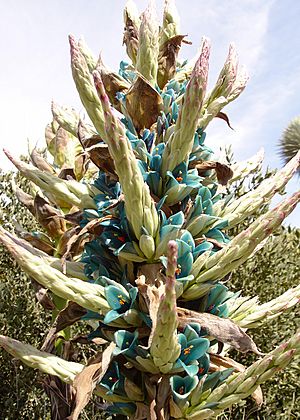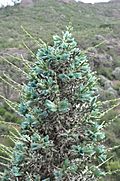Puya alpestris facts for kids
Quick facts for kids Puya alpestris |
|
|---|---|
 |
|
| Puya alpestris flowers at the Huntington Desert Garden in San Marino, California. | |
| Conservation status | |
| Scientific classification | |
| Genus: |
Puya
|
| Species: |
alpestris
|
| Synonyms | |
|
|
The Puya alpestris is a special plant from the bromeliad family. It grows naturally in the Chilean Andes mountains. You can find it on dry hills and rocky areas in central and southern Chile. It lives at different heights, from sea level up to 2,200 meters (about 7,200 feet). This plant is one of the few Puya types that people grow in gardens because it looks so beautiful.
Contents
What Does it Look Like?
The Puya alpestris is a plant that lives for many years. It is also a "xerophyte," which means it can live in very dry places. It has a short stem with a thick bunch of leaves that look like a rose (this is called a "rosette").
Its leaves are tough and stick out stiffly. They have lines running through them and end in a sharp point. Each leaf can be over 1 meter (about 3 feet) long and about 2 to 2.5 centimeters (1 inch) wide. The edges of the leaves have hooked, curved spines, which are about 0.5 cm long. The underside of the leaves is covered in tiny, dense white scales.
Flowers and Life Cycle
After many years, the plant grows a tall, loose flower stalk. This stalk is made up of many smaller flower branches. The lower part of these branches has tiny, star-shaped hairs. The stalk holds many bright red leaves called "bracts" and lots of individual flowers. The very tips of the flower branches don't have flowers.
Each flower sits on a small stalk about 7 mm long. The flowers have both male and female parts. They have three greenish outer leaves called "sepals," which are about 2.3 cm long. They also have three beautiful teal-colored petals with rounded tips, about 4.5 cm long. As the flowers get older, these petals curl inwards. There are six "stamens" (the male parts) with bright orange "anthers" (which hold pollen).
These flowers make a lot of sweet liquid called "nectar." This nectar attracts hummingbirds and other birds, which help the plant make seeds by moving pollen from flower to flower. This process is called "pollination." In its natural home, the plant blooms between October and December.
After the flowers are pollinated, they form "capsule fruits." Inside these fruits are many small, light seeds that can be carried by the wind. Once the plant has made seeds and new baby plants start to grow, the original "mother plant" slowly dies.
Plant Family and Types
The Puya alpestris was first described by a person named Eduard Friedrich Poeppig in 1833. The name "alpestris" means "living in the Alps," which refers to the Andes mountains where this plant grows.
Different Kinds of Puya alpestris
There are two main types, or "subspecies," of Puya alpestris:
Images for kids
See also
 In Spanish: Puya alpestris para niños
In Spanish: Puya alpestris para niños












